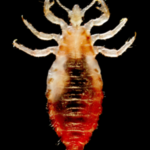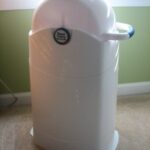My ten-month-old woke up one morning and as I was changing her diaper, I noticed something in her hair. I pulled out a little bug assuming that it had flown in through the open window and landed on her. Then I looked closer, and realized that her head was crawling. So this week we have had a crash-course in treating babies for lice.
Here are some tips for identifying and then handling head lice in babies.
1. Diagnose the problem.
First of all, you have to identify that your baby does actually have lice. It may seem stupid to list this, but it’s actually an important (and sometimes surprisingly difficult) step. Even after seeing the disgusting little bugs in her hair, I still didn’t immediately realize that she had lice. As far as I knew, she hadn’t come into contact with anyone with lice. I hadn’t seen any signs of lice in her hair before, and her hair was clean. Also, I had never had lice, and had never actually seen them before. Somehow I expected lice to be much smaller. Mature lice are much bigger than fleas, and are easily visible with the naked eye. In a bad infestation, you can see them crawling in their hair without even having to comb through it.
So, if you see something crawling on your baby’s head, it’s probably lice. If you’re not sure, there are a lot of websites with pictures of lice and descriptions that can help you to identify them. If you’re still not sure, talk to someone (like another parent or a pharmacist or doctor) that can help.
Just a word of warning about this problem. When I called a nursery my daughter had visited and told them that my daughter had lice, the nursery worker told me that it was impossible because “babies don’t have hair.” Obviously this is ridiculous because lots of newborn babies have hair, and hardly any babies are still bald by the time they’re a year old. Babies of any age can catch lice. If you see any signs of eggs or little bugs in their hair, not matter how young your child is, they probably have lice.
2. Treat the problem.
There are a lot of lice treatments on the market, but beware: most of them are unsuitable for children under the age of three. If you’re treating a baby, you need to put in some extra effort.
The first thing to do is to invest in a lice comb (many of these will be labeled as being suitable from age three up, but as you have to comb their hair, and a comb is not going to harm your baby, buy one anyway). Wet their hair and put in either some baby conditioning shampoo or a little olive oil, and then comb through it with the lice comb. Wipe the comb clean after every brush through their hair. (I recommend wiping it off on some paper towel and then putting the paper towel in a sealed zip lock bag before throwing it away.) Start each stroke as close to their scalp as you can and run it all the way through to the tips of their hair. Comb each area until the comb comes out clean.
Then you need to treat their hair for any lice or eggs that you missed with the comb (it’s almost impossible to get them all out by just combing). I recommend a dual medical and homeopathic approach to treat them.
You can get baby lice shampoo on prescription from your doctor-most doctors will write one if you just call in, because they don’t want you to actually bring a lice infested child into their office and contaminate other people. It is milder than other treatments, and so has to be left in their hair for twelve hours. The easiest way is to put it in their hair before they go to bed, and then wash it out when they wake up in the morning. They will need a second treatment a week later.
There are also homeopathic remedies that can help. They day after using the medicine treatment, you can make a concoction of beeswax and different essential oils that will help to kill existing lice and prevent re-infestation (you can find recipes on websites or in holistic medicine books, but for a simple treatment, melt several tablespoons of beeswax, let cool a little, and then add about ten drops each of lavender, geranium, tea tree, and rosemary oil. All of these ingredients should be available to buy at specialty health or holistic stores, but if you can’t find them all, you can leave out some of the oils. It will be slightly less effective, but will still help.) Lavender oil is particularly good, so you can rub a little lavender oil into their hair and scalp every few days until you’re sure that they’re lice free.
3. Treat the house.
There’s no point getting the lice out of your child’s hair if new lice are going to crawl straight back into them. Your house, car, etc. will need to be treated. First of all, all clothing, bedding, towels, and soft toys that your child has come into contact with should be washed on a hot setting in the washing machine and then, if possible, tumble dried on high. Lice can live for up to two days off of a person, and are most likely to survive on surfaces like carpets and stuffed animals. You can buy lice killer spray, or if you can’t find it, just use a good antibacterial spray, and clean everything. Make sure to remember things like strollers and carseats. Vacuum all of your carpets. Try to think of anything that could have lice on it, and then get rid of them!
Also, make sure that no one else in the family has been infected. Lice spread quickly, so the whole family should have their hair combed through to check for any signs of lice. If there are any eggs or lice, they need to be treated as well. If they don’t have lice, it’s still a good idea to rub lavender oil into their hair and scalp as a preventative measure.
4. Warn other people.
You will need to call people that have been in contact with your baby recently and warn them. This can be awkward, but it’s only fair to warn people so that they can be on the lookout for lice. Make sure to include people you go to church with, any childcare your baby may go to, friends who have come over the play, etc.
5. Comfort your baby.
Your baby doesn’t understand what’s going on. Suddenly their head may be uncomfortable and itchy, you’re trying to hold them without letting them rub their head on you, and their poor hair is being combed and having stuff rubbed into it constantly. Tell them that they are being good, try to comfort them, and give them treats for letting you treat their hair.





